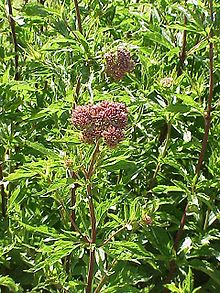Konopljuša |
Resnik
Eupatorium cannabinum
Koristi se:
Kod oboljenja žuči, jetre, snižava krvni pritisak, holesterol i
triglicerin.
Upotreba:
Jednu kašičicu usitnjene biljke preliti sa 100ml vrele vode, stoji
10 minuta, piti ujutru šolju čaja sa jednom kašičicom meda i jednom kašikom
jabukovog sirćeta. Pije se najduže 7 dana, pa pauza 3 dana.
Dragica Milšević
381 (0) 62 1133208
Eupatorium cannabinum
From Wikipedia, the free encyclopedia
| Eupatorium cannabinum | |
|---|---|
 | |
| IJmuiden, Netherlands | |
| Scientific classification | |
| Kingdom: | Plantae |
| (unranked): | Angiosperms |
| (unranked): | Eudicots |
| (unranked): | Asterids |
| Order: | Asterales |
| Family: | Asteraceae |
| Tribe: | Eupatorieae |
| Genus: | Eupatorium |
| Species: | E. cannabinum |
| Binomial name | |
| Eupatorium cannabinum L. | |
| Synonyms[1] | |
| Wikimedia Commons has media related to Eupatorium cannabinum. |
Eupatorium cannabinum, commonly known as hemp-agrimony,[2] or holy rope,[3] is a herbaceous plant of the daisy family. It is a robust perennial native to many areas of Europe.[4][3] It is cultivated as an ornamental and occasionally found as a garden escape in scattered locations in China,[5] the United States and Canada.[6][7]
If the genus Eupatorium is defined in a restricted sense (about 42 species), E. cannabinum is the only species of that genus native to Europe (with the remainder in Asia or North America).[8]
Description[edit]
Eupatorium cannabinum is a perennial herb up to 1.5 meters (4.9 feet) tall or more and 1.2 meters (3.9 feet) wide.[4] It lives in moist low-lying areas in temperate Eurasia. It is dioecious, withracemes of mauve flower heads which are pollinated by insects from July to early September. The flowers are visited by many types of insects, and can be characterized by a generalizedpollination syndrome.[9] The flower heads are tiny, fluffy and can be pale dusty pink or whitish.[4] The fruit is an achene about 2 or 3 mm long, borne by a pappus with hairs 3 to 5 mm long, which is distributed by the wind. The plant over-winters as a hemicryptophyte.[8]
Toxicity[edit]
- Subspecies
- Eupatorium cannabinum L. subsp. cannabinum - most of species range
- Eupatorium cannabinum L. subsp. corsicum (Req. ex Loisel.) P.Fourn. - Corsica, Sardinia, Basilicata, Apulia
References[edit]
- ^ The Plant List, Eupatorium cannabinum L.
- ^ "BSBI List 2007". Botanical Society of Britain and Ireland. Archived from the original (xls) on 2015-02-25. Retrieved 2014-10-17.
- ^ a b Altervista Flora Italiana, Holy Rope, gewöhnlicher Wasserdost, hampflockel, Canapa acquatica includes photos and European distribution map
- ^ a b c "Botanica. The Illustrated AZ of over 10000 garden plants and how to cultivate them", p 359. Könemann, 2004. ISBN 3-8331-1253-0
- ^ Flora of China, Eupatorium cannabinum Linnaeus, 1753. 大麻叶泽兰 da ma ye ze lan
- ^ "Eupatorium cannabinum". Flora of North America.
- ^ Biota of North America Program 2014 county distribution map
- ^ a b Schmidt, Gregory J. & Schilling, Edward E. (2000): Phylogeny and biogeography of Eupatorium (Asteraceae: Eupatorieae) based on nuclear ITS sequence data. Am. J. Bot. 87(5): 716-726.doi:10.2307/2656858 PMID 10811796 PDF fulltext
- ^ Van Der Kooi, C. J.; Pen, I.; Staal, M.; Stavenga, D. G.; Elzenga, J. T. M. (2015). "Competition for pollinators and intra-communal spectral dissimilarity of flowers" (PDF). Plant Biology.doi:10.1111/plb.12328.
- ^ Fu, P.P., Yang, Y.C., Xia, Q., Chou, M.C., Cui, Y.Y., Lin G., "Pyrrolizidine alkaloids-tumorigenic components in Chinese herbal medicines and dietary supplements", Journal of Food and Drug Analysis, Vol. 10, No. 4, 2002, pp. 198-211 [1]


Нема коментара:
Постави коментар